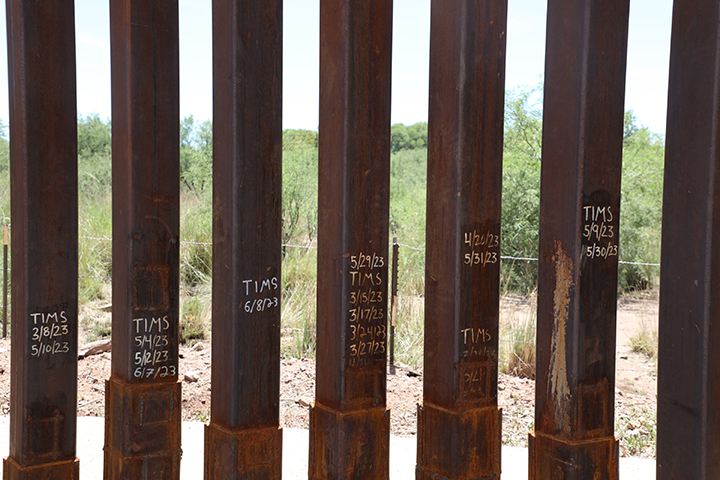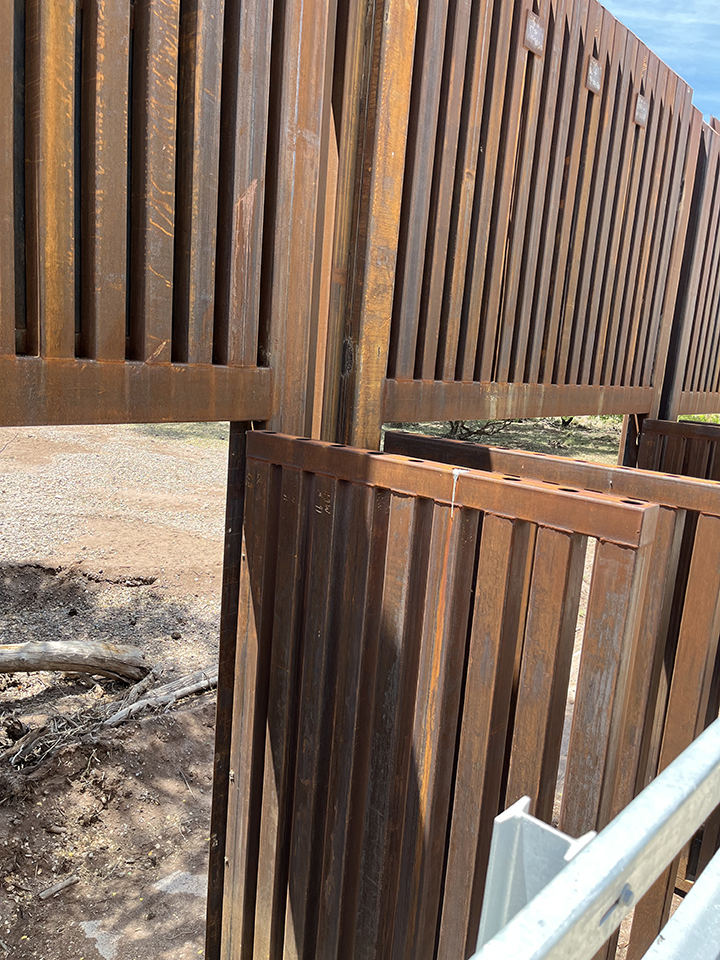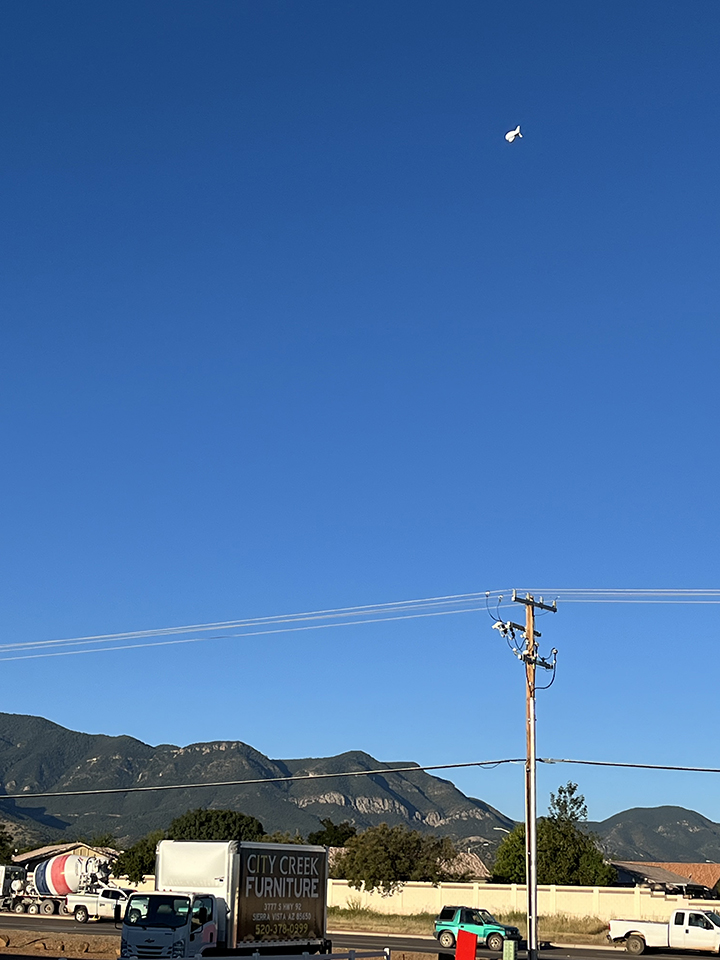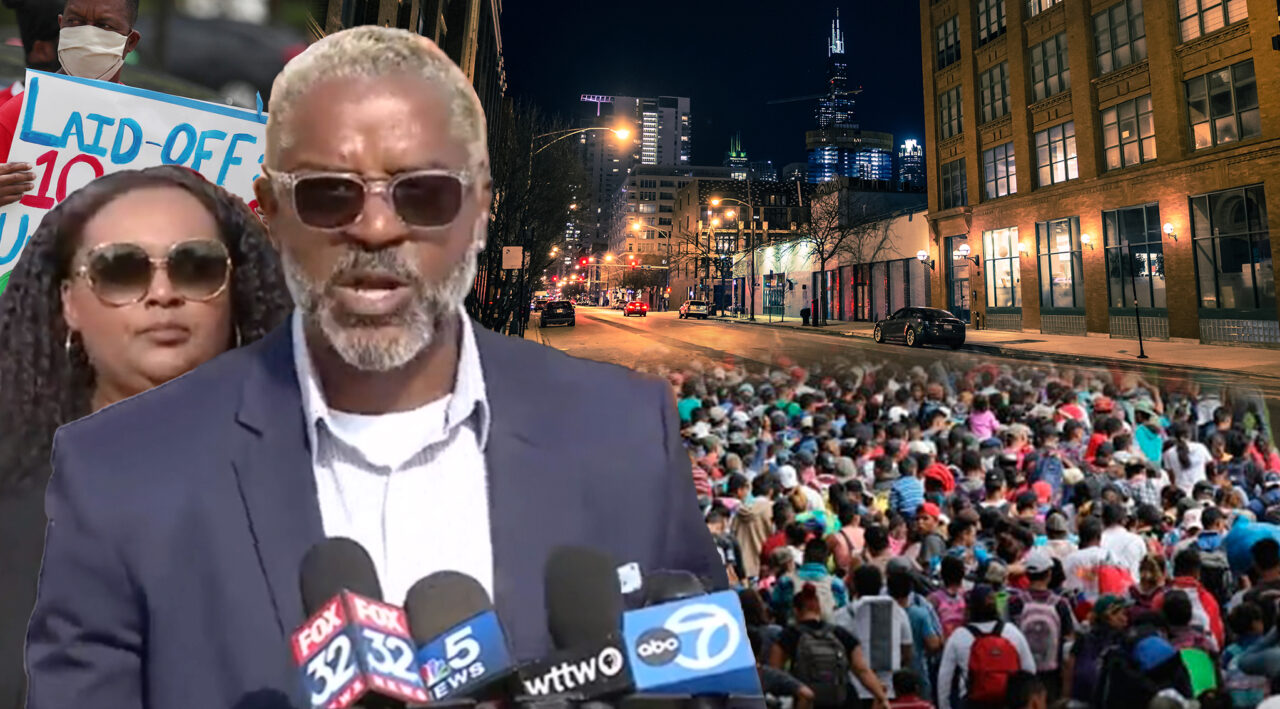Two Scenes from Biden’s Border Crisis
I’ve just returned from southeastern Arizona where I testified at a joint congressional hearing captioned “Biden’s Border Crisis and Its Effect on American Communities”. Apart from the hearing, two scenes from the area stood out in particular: one a series of open gates along fencing tens of miles long in Coronado National Monument; and the other, a grounded tethered blimp (known as an “aerostat”) that had previously kept watch over the border high above the U.S. side of the Sonoran Desert. Combined, the message they sent to smugglers and the cartels was, “Come on in — but don’t tell anybody.”
Cochise County and Tucson Sector. That hearing was held in Sierra Vista, the most populous city in Cochise County, which in turn is the southeasternmost county in Arizona. Cochise County is huge — at 6,219 square miles, it’s as large as Connecticut and Rhode Island combined. Still, with just fewer than 126,000 residents, it’s sparsely populated, and most of it (60 percent) is either state or federal land.
It also occupies the southeastern corner of the Border Patrol’s Tucson sector, which has jurisdiction over 262 miles of the 1,954-mile Southwest border. Tucson sector has seen the lion’s share of the border’s post-Title 42 illegal entrants — who were likely pushed westward by the state of Texas’s successful (and much derided) border-security effort, known as “Operation Lone Star”.
There’s no similar state border-control effort in Arizona. In fact, when I was down there, I was told that the state’s governor, Katie Hobbs (D), is actively attempting to remove the Arizona National Guard troops sent to the border by her predecessor, Gov. Doug Ducey (R), to provide federal and local authorities with logistical and humanitarian assistance — even though boosting the number of troops had reportedly been a potential part of her post-Title 42 plans.
That’s a problem because I saw few Border Patrol agents on the border there. They have apparently been drawn off the line to transport, process, care for, and (usually) release the thousands of migrants who are pouring into Tucson sector monthly, though a handful were staffing a local highway checkpoint.
Mud and Miasma. There is a small substation in Coronado National Monument, but at 11:00 AM on a Tuesday morning, the parking lot there was full of vehicles that weren’t patrolling. One vehicle that I did see on the border road seemed more interested in watching me and my party.
Not that I could blame them, because the road was a muddy mess after a series of rare summer storms had passed through the region the day before. Locals I spoke to blessed — or blamed — me for bringing the rain with me more than once.
The border road wouldn’t have been in such shape if President Biden had not — in a fit of partisan pique — proclaimed a “pause” on “border wall construction” on his first day in office, essentially halting what the Washington Post referred to as “the Trump administration’s signature infrastructure project”.
The DHS “Border Wall System” to which that order applied is a bit of a misnomer, as “it includes not just fencing (consisting of ‘internally hardened steel-bollard barriers from 18’ to 30’ high’), but also “new and improved all-weather access roads”, “perimeter lighting”, and “enforcement cameras”, as well as “other related technology”.
The gravel that should have been spread along the border fence road in Coronado National Monument instead sits in piles more than six feet high that stretch for a mile or more along the muddy roadbed, a constant visual slap in the face to the few agents who deign to traverse the path. Of course, those piles only start east of the mile-plus stacks of unused fencing panels that sit rusting where they lay when that order was issued.
Fortunately, I was there in the morning. If we had come at night, most of that tens of millions of dollars in wasted government materiel would have been obscured in the darkness because the miles of light posts that are supposed to illuminate the border darkness are either incomplete or — just as often — not hooked to any power source.
As Fr. Kerr, my Latin teacher, would have asked, “Cui bono?”, that is, “Who benefits?” Not you, me, or the agents. Somewhere in Washington, D.C., however, the president’s immigration advisors — who have likely never been there — think this mud and miasma is a swell idea.
Democratic longshot presidential candidate Robert F. Kennedy, Jr. does not concur with that assessment. As he recently explained in a Substack post captioned “As President, I Am Going to End the Humanitarian Crisis at the Border”:
Ruthless criminal cartels have woven drugs, immigration, and human trafficking together into a multi-billion dollar business.
Biden administration policy has greatly exacerbated the situation. The border is out of control. Immigration is being administered by the cartels, not our government.
Just as a cell has a membrane, a country must have borders or it will disintegrate.
Above: Repairs in the border fence in Arizona. Below: Storm gates stand open in the border fence. Photos by Andrew Arthur.
Fortunately for you, me, RFK Jr., the agents, and anyone concerned about the border crisis and its attendant drug overdose epidemic, the “Southeastern Arizona Border Region Enforcement Team” (SABRE), an initiative of the Cochise County Sheriff’s Office, has stepped in to try to fill the void.
SABRE deputies have set up cameras at high-traffic smuggling corridors along the border, largely on the county’s dime, and pursue evaders on state charges. This effort is not entirely selfless, though.
I was told that there are dozens of high-speed chases across the county weekly, and many of the drivers are teenage idiots from far-away towns and cities, lured to the border via social media to serve as cartel mules carrying drug and migrant “loads” with promises of adventure and easy cash.
The Open Gate. Of course, the Bush, Obama, and Trump administrations did erect border fencing before Joe Biden took office, and from a promontory in Coronado National Monument you can see it stretch to the eastern horizon.
The term “arroyo” is used to describe a gully in the desert created when sporadic rains send streams of water through low-lying areas, and a prominent one runs south from the mountains across the border to the Mexican side of the monument. It creates a perfect spot for smugglers and migrants to hide.
Construction crews managed to build an east-west bridge along the road across that arroyo parallel to the fence before President Biden took office. The fence adjacent to that arroyo bears repair scars from places where smugglers had cut through to gain access to the U.S. side.
Those scars are all old, however, because coyotes and mules no longer need to cut through the fence to enter the United States. They can simply enter through the arroyo storm gates at the base of the fence. Those gates were open when I was in the area when I was there in September and remain open today.
In fact, I was told that they have been closed for just two months in the past year — in an area that gets just 20 inches of precipitation annually. There is no better image for border security in the age of Biden than the wide-open gates at the border arroyo in Coronado National Monument. It’s the Ellis Island of the 21st century.
The Missing Blimp. Once upon a time, Joe Biden was a big fan of border fences. At a campaign stop in Winterset, Iowa, in August 2007, the then-candidate explained:
It makes sense that no great nation can be in a position where they can’t control their borders. It matters how you control your borders … not just for immigration, but for drugs, terror, a whole range of other things. … I have been arguing for more protection at the borders. … You have to have a significant increase in security at the border, including limited elements where you actually have a fence. Not a fence that runs for 3,000 miles like some folks are talking about, but there are certain places — you can go over and under a fence, but you can’t take 100 kilos of cocaine over and under a fence. And, when you have limited places where fences are in populated areas, you force these drug dealers and others around, making it easier to apprehend. [Emphasis added.]
On the 2020 campaign trail, Biden reversed that position, contending, “Building a wall will do little to deter criminals and cartels seeking to exploit our borders.” Of course, at the time he also championed investments in “in better technology coupled with privacy protections at the border, both at and between ports of entry, including cameras, sensors, large-scale x-ray machines, and fixed towers.”
Which brings me to the missing blimp, technically an “aerostat” because it is tethered to the ground, part of CBP’s “Tethered Aerostat Radar System” (TARS), which has a visual range of 200 miles. As Rob Brown, CBP’s then-TARS program manager explained in 2016:
The aerostats are aerodynamic balloons and fly like kites in the wind—no one pilots them … . Raising radar and other sensors to high altitude boosts surveillance range, and the physical sight of an aerostat is a visual deterrent to illegal activity in the air and on the ground.
A blimp watching over the Arizona border last September. Photo by Andrew Arthur.
The one at Fort Huachuca in Cochise County has been keeping a watchful “eye in the sky” for decades, and has been operated by CBP for at least 10 years. It floated on the horizon over the Sierra Vista Mall when I was there in September, but it was grounded and bouncing in a nearby field like a huge white Teletubby when I was driving to the hearing on August 8.
When I asked a local official why the aerostat wasn’t flying on that clement day, he smirked and said, “Because there’s a cloud in the sky.” They don’t do well in windy weather, for sure, but the word around town was that the Biden administration wanted to ground them all, permanently.
That dovetails with a February Fox News report, which revealed that CBP is planning on thinning its aerostat fleet as DHS has “cut funding for the program”.
Why would a president who ran on promises to implement “better technology coupled with privacy protections at the border … including cameras [and] sensors” in lieu of erecting fences want to ditch an airborne surveillance system with a range of 200 miles?
Local officials provided the answer: The administration doesn’t want to know what and who the virtually non-existent Border Patrol agents aren’t apprehending, and it doesn’t want you to know, either.
“Got-Aways”. In 2017, Congress identified metrics directly related to border security, and to gauge CBP’s ability to deter illegal entrants, which are now codified at 6 U.S.C. §223. Among those metrics is the number of “got-aways”, defined therein as: “an unlawful border crosser who- (A) is directly or indirectly observed making an unlawful entry into the United States; (B) is not apprehended; and (C) is not a turn back”.
In June, I reported that the number of “got-aways” at the Southwest border has surged since President Biden took office, as illegal migrants have evaded increasingly overwhelmed Border Patrol agents to successfully make their way into the interior.
Between FY 2010 — when DHS began compiling got-away statistics — and FY 2020, the number of successful illegal entrants never exceeded 172,000 in any given fiscal year, and in most years didn’t top 130,000.
In FY 2021, however, DHS recorded more than 389,000 got-aways, and then nearly 600,000 in FY 2022. At a May 11 White House press conference, DHS Secretary Alejandro Mayorkas was asked about reports that there had already been more than 530,000 gotaways in FY 2023 (“roughly the size of the population of the city of Baltimore”), which he pointedly did not deny.
Combined, that’s more than 1.5 million aliens who have entered illegally on Biden’s watch, who are now living in the United States, largely free from any official constraint — “roughly the size of the population of Philadelphia”, America’s sixth-largest city. In turn, it’s a significant political liability for the president headed into the 2024 general election.
Mayorkas is doing nothing to stop those migrants from entering, but he could duck the headache and slash the got-away numbers by diminishing CBP’s ability to identify illegal entrants whom agents are unable to catch.
Or, as Rodney Scott, Biden’s first Border Patrol chief told Fox News: “This administration doesn’t really, truly care about securing the border. They care about optics by dropping these aerostats … . So they’re going to lose one more visual into what’s really going on.”
Once again, who benefits? Not the American people, but instead the smugglers, drug mules, cartels, and migrants themselves, and — significantly — the White House and Mayorkas to boot.
The wide-open gates in the border fence beckoning smugglers and migrants into the United States highlight the Biden administration’s indifference to border security, but the missing blimp shows the White House recognizes the political hazards of its open-border schemes. Combined they send a message to the cartels and coyotes: “Come on in — but don’t tell anybody”.








